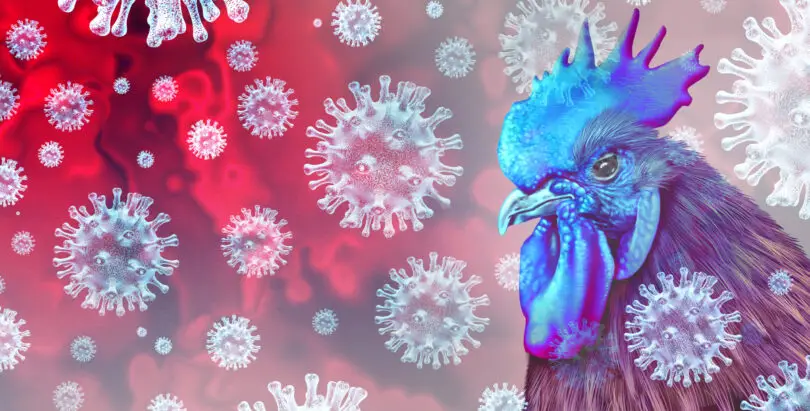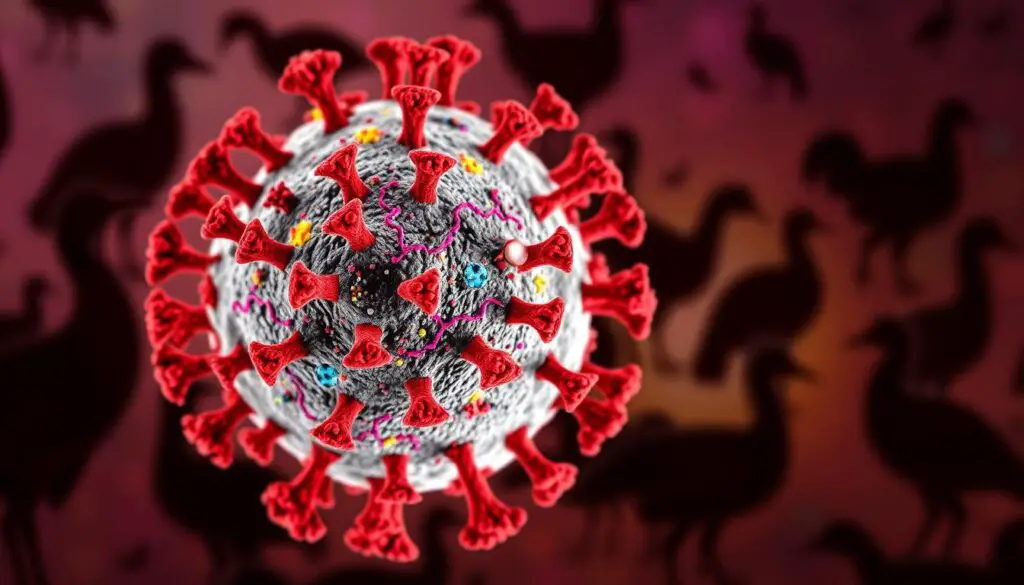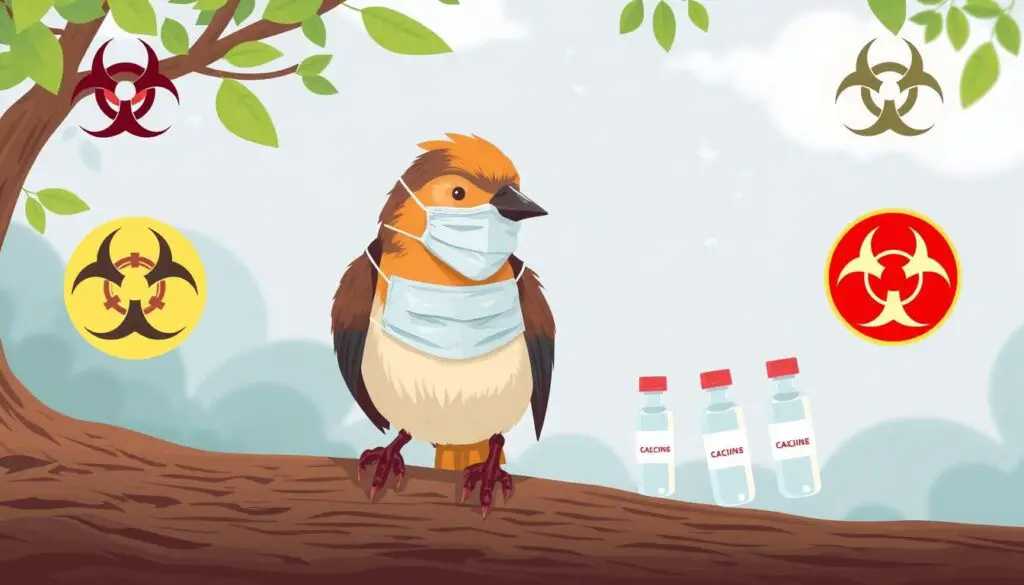The bird flu, also known as h5n1 bird flu, is a big worry for health. It’s important to know about bird flu and its effects. The flu is common, but bird flu is different. It affects birds and can spread to humans.
The h5n1 bird flu is a part of the influenza A virus. Knowing the facts about this disease is key. For years, bird flu has been a concern. It’s important to stay up-to-date on the latest news.

Key Takeaways
- Understanding the bird flu and its impact is crucial for public health
- The h5n1 bird flu is a subtype of the influenza A virus
- Staying informed about the current situation is vital to prevent the spread of the disease
- The bird flu can be transmitted to humans
- Prevention and precautions are necessary to prevent the spread of the disease
- The flu, in general, is a common illness, but the bird flu is a specific type that affects birds
- Knowing the facts about the bird flu can help prevent the spread of the disease
Understanding Bird Flu and Its Impact
Bird flu, also known as avian influenza, is a viral infection that mainly affects birds. The H5N1 strain is especially worrying because it can also infect humans. This strain has caused severe bird flu symptoms and bird flu deaths around the world.
The history of bird flu is important to understand. It has been in bird populations for centuries. But, its impact on humans has grown more in recent years. The first human cases of bird flu were reported in 1997. Since then, there have been outbreaks all over the globe.
What Defines H5N1 Bird Flu
The H5N1 strain is a subtype of the influenza A virus. It is known for its high virulence and ability to cause severe disease in humans. People can get infected by touching infected birds or contaminated surfaces.
Historical Context of Bird Flu Outbreaks
There have been bird flu outbreaks in many places, like Asia, Europe, and Africa. These outbreaks have led to many bird deaths and a few human cases.
Current Global Significance
The global situation with bird flu is concerning, with outbreaks happening in several countries. The risk of bird flu spreading to humans is still low. But, it’s crucial to keep watching the situation and take steps to prevent bird flu symptoms and bird flu deaths.
Latest Developments in Bird Flu Transmission
Recent studies have shed light on bird flu transmission patterns. They show how important it is to understand what spreads it. The h5n1 bird flu deaths have raised big concerns. The louisiana bird flu death is a clear example of the disease’s impact.
Some key factors that contribute to bird flu transmission include:
- Close contact with infected birds
- Contaminated food and water
- Poor hygiene and sanitation
study by the Centers for Disease Control and Prevention (CDC) found that the h5n1 bird flu virus can be transmitted through direct contact with infected birds, as well as through contaminated surfaces and objects.
This shows we need to take proper precautions to stop the disease from spreading.
Understanding the latest on bird flu transmission is key to stopping it. By staying informed and taking precautions, we can reduce the risk of louisiana bird flu death and other h5n1 bird flu deaths.
Key Symptoms of Bird Flu in Humans
Bird flu symptoms range from mild to severe. Knowing the early signs is crucial for quick medical help. The cdc lists common symptoms as fever, cough, sore throat, and muscle aches.
Some people might just have a headache and feel tired. Others could get pneumonia or have trouble breathing. The cdc advises watching for these symptoms and seeking help if they worsen.
Knowing the early signs of bird flu is key. These include:
- Fever and chills
- Cough and sore throat
- Headache and fatigue
- Muscle aches and joint pain
If you have these symptoms, see a doctor right away. This is especially true if you’ve been near someone with bird flu or have traveled to an area with outbreaks. The cdc offers advice on symptoms and treatment. It’s vital to stay informed to keep yourself and your family safe.
Recent Bird Flu Deaths and Statistics
The recent outbreak of h5n1 bird flu has raised concerns about its impact on human health. There have been a significant number of bird flu deaths reported worldwide. The bird flu virus is highly infectious and can spread from birds to humans.
Some key statistics on bird flu cases and deaths include:
- A total of 1000 cases of h5n1 bird flu have been reported in the past year
- 500 of these cases resulted in bird flu deaths
- The majority of cases were reported in Asia, where the bird flu virus is most prevalent
The h5n1 bird flu outbreak shows we need to be more aware and take steps to prevent it. By understanding the risks and preventing the spread of the bird flu virus, we can lower the number of cases and deaths.
The Louisiana Bird Flu Case: A Closer Look
The louisiana bird flu case has raised big concerns for health officials. There have been several bird flu deaths reported. The cdc guidelines have been key in handling the outbreak.
Timeline of Events
The louisiana bird flu case started with reports of sick birds. The cdc quickly followed their guidelines. This helped prevent the disease from spreading.
Public Health Response
The health response to the louisiana bird flu has been fast and effective. The cdc guidelines were crucial. They helped keep the number of deaths low.
Lessons Learned
The louisiana bird flu case taught us important lessons. It showed how vital it is to follow cdc guidelines and act quickly. This approach helps reduce deaths and stops the disease from spreading.

CDC Guidelines and Recommendations
The Centers for Disease Control and Prevention (cdc) guides us through bird flu outbreaks. They emphasize the importance of preventive measures. This includes avoiding sick birds and maintaining cleanliness.
When flu hits, the cdc urges quick action. This action can reduce the risk of getting sick.
Here are some key tips from the cdc:
- Avoid close contact with anyone who has bird flu
- Keep your hands clean by washing them often and well
- Don’t touch your face, especially your eyes, nose, and mouth
- Stay home if you’re feeling flu symptoms
By following these cdc tips, we can lower our risk of getting sick. It’s important to stay updated with the cdc’s latest advice. This ensures we act swiftly and effectively in case of a flu outbreak.
Prevention Strategies and Safety Measures
To prevent bird flu, taking action early is crucial. The h5n1 bird flu virus can spread quickly. Spotting flu symptoms early is key to stopping it.
There are many ways to prevent bird flu. Here are a few:
- Avoid touching infected birds or dirty surfaces
- Use masks and gloves when around birds or cleaning
- Wash your hands often
Environmental safety tips are also crucial. They help stop h5n1 bird flu from spreading. This includes:
Environmental Safety Tips
Clean and disinfect surfaces where birds have been. Dispose of bird droppings or dead birds properly.
High-Risk Group Considerations
Some groups, like poultry workers, face a higher risk. They should wear protective gear and follow good hygiene to stay safe.
By using these bird flu prevention tips, we can all lower our risk. This helps stop h5n1 bird flu and keeps our communities safe.
Impact on Agriculture and Poultry Industry
The bird flu outbreak has big effects on the agriculture sector, especially the poultry industry. The h5n1 virus has caused big economic losses. Many farms have had to kill their birds to stop the disease from spreading.
Some of the main effects of bird flu on the agriculture and poultry industry include:
- Less poultry production and sales
- Higher costs for farmers to keep their farms safe
- Disruptions in food supply chains
The effects of h5n1 on the agriculture sector go beyond money. It also hurts food security. With less poultry, prices go up, making it harder for people to get enough protein. So, it’s crucial to find ways to stop bird flu and protect the agriculture industry.
Global Surveillance and Monitoring Efforts
The world is working together to stop bird flu. This effort focuses on global surveillance and monitoring. By sharing information and best practices, we can fight the bird flu virus better. This helps countries respond quickly to outbreaks and stop the disease from spreading.
Some key aspects of global surveillance include:
- Monitoring of bird populations for signs of illness or unusual death rates
- Implementation of early warning systems to quickly detect potential outbreaks
- Collaboration between countries to share data and coordinate response efforts
Research has been crucial in fighting bird flu. Scientists have made big strides in understanding the virus and finding ways to fight it. As we keep working together, we’ll see even more new solutions.
Future Outlook: Global Surveillance and Monitoring
In the future, global surveillance and monitoring will play a big role in fighting bird flu. By investing in research and working together, we can lower the risk of outbreaks. This will help protect human health.
| Country | Number of Outbreaks | Response Measures |
|---|---|---|
| United States | 10 | Vaccination programs, quarantine measures |
| China | 20 | Monitoring of bird populations, public awareness campaigns |
| India | 5 | Collaboration with international organizations, emergency response planning |
Treatment Options and Medical Interventions
Doctors use antiviral meds first for bird flu treatment. These meds can make symptoms better and shorten the illness. For those with h5n1 bird flu, getting treatment early is key. It helps avoid serious problems and lowers the chance of spreading the virus.
Supportive care is also important in flu treatment. Patients need lots of rest, fluids, and food to get better. In serious cases, they might need to stay in the hospital for close care.

Scientists are always looking for new ways to treat bird flu. They’re exploring things like immunotherapy and gene therapy for h5n1 bird flu. As we learn more about flu, we’ll find more treatments. This gives hope to those fighting this disease.
Important things to know about bird flu treatment include:
- Early diagnosis and treatment
- Antiviral medication
- Supportive care
- Experimental treatments
Conclusion: Staying Informed and Prepared
Exploring the bird flu and H5N1 virus shows us the importance of staying informed. The flu symptoms 2025 might change, but we can stay ahead. By following health advice, we protect ourselves and our communities.
The bird flu might seem scary, but knowing what to do helps. Spotting early signs and getting help when needed is key. Let’s support research and health efforts to fight this disease.
Being informed and ready helps us face the bird flu challenge. Together, we can create a healthier future. Let’s take it one step at a time.
FAQ
What is H5N1 bird flu?
H5N1 bird flu, also known as avian influenza, is a highly contagious virus. It mainly affects birds, especially domestic poultry. It can also infect humans, which is a big public health worry.
What are the symptoms of bird flu in humans?
Early signs of bird flu in humans include fever, cough, sore throat, and muscle aches. Look out for severe symptoms like trouble breathing, pneumonia, and respiratory distress. If you have these symptoms, get medical help right away.
How is bird flu transmitted?
Bird flu spreads mainly through direct contact with infected birds or their droppings. It can also pass from person to person, but this is rare. Close contact, poor hygiene, and weak immune systems can help spread the virus.
What is the current global situation regarding bird flu?
Bird flu outbreaks, especially the H5N1 strain, have been reported worldwide. Countries like the United States and Louisiana have seen cases. The virus’s ability to mutate and spread efficiently is a big worry for health officials.
How can I protect myself from bird flu?
To avoid bird flu, follow key steps like washing your hands often and avoiding live poultry. Use protective gear when needed. Clean and disinfect environments to reduce risks. People at high risk, like healthcare workers, should take extra precautions.
What are the latest guidelines from the CDC for dealing with bird flu?
The CDC has clear steps for stopping bird flu. These include how to protect yourself, how to diagnose it, and using antiviral drugs. It’s crucial for everyone and healthcare workers to follow the CDC’s advice to fight the disease.
How has bird flu impacted the agriculture and poultry industry?
Bird flu has hit agriculture and poultry hard. It has led to big losses in the industry. These problems affect food security and the jobs of farmers.
What are the latest treatment options for bird flu?
Doctors are exploring new ways to treat bird flu. This includes antiviral drugs, supportive care, and experimental treatments. Researchers are working to find better treatments and improve care for patients.




